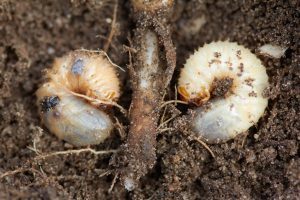MGG’s Ryan Anderson describes the grub life cycle and how to monitor and disrupt it to protect your turf’s roots.

For many lawn owners, brown grass works us into a frenzy. Did I kill the grass? Did I not provide enough nutrients and/or water? Or too much? Worse yet… does my lawn have grubs?
Many times, brown means little for the health of your grass. In times of drought or minimal water, turf enters a natural state of dormancy to cope with the harsh conditions and will green back up the first rain this fall.
However, if you start seeing random alignments of brown spots in your lawn, it may indicate a larger problem such as fertilizer, weed killer, or pet urine burns, harmed grass from dull mower blades, or, yes, the dreaded grub infestation.
The first step to grub control is confirming that you have a grub problem. Small grub populations cause minimal damage to grass and any one of the conditions mentioned above could cause turf browning. If brown grass rolls up like a carpet when pulled, grubs likely got to your roots.
To detect grubs before damage, grab a shovel and tape measure and head to an area of your lawn important to you. With your shovel cut three sides of a 12-inch square and pull back the turf. Pick and count the c-shaped critters from your sample. A grub population that exceeds six grubs may cause damage and can warrant control.
For control, it’s essential to understand the life cycle of the Japanese beetle (i.e. the most common species of white grub found in lawns), so you can disrupt it. In June or early July, Japanese beetles hatch from the ground into their fully bodied scarab beetle stage. During this phase, they do not feed on grass roots and hang around the foliage of other plants. The beetle’s tendency to live higher than the root layer during this phase deems grub control, organic or synthetic, ineffective during July and early August.
By August, however, the beetles start to lay eggs. In a couple weeks, these eggs will hatch into the c-shaped grubs that your lawn’s roots dread. Right about now (September), these larval insects will grow to a state susceptible to biological and chemical control.
Beneficial nematodes provide the best biological, non-toxic control in September. These microscopic parasites search for grubs and release a fungus once they hit pay dirt that consumes the pests. Just like grubs, nematodes prefer damp grass conditions. Sunlight may actually immobilize them, so nematode application should take place at dusk or during overcast/rainy conditions.
To find these grub attackers, search for beneficial nematodes and choose Heterorhabditis bacteriophora (HB) products. Some companies that sell effective nematode products include ARBICO Organics, BioLogic, and Green Methods. You can store nematodes in any standard fridge for two to three weeks.
For less handling, lawn managers can, also, consider the bacterium Milky Spore for Japanese Beetle control. This bacterium works by spreading and growing spores that can be deadly to grubs by ingestion. Milky Spore only harms Japanese Beetles, however, meaning that they will not control masked chafers, the second most popular grub found in lawns. Yet, after establishing this bacterium, Milky Spore can stay effective in controlling Japanese Beetles for three years without need of replacement. Even better, Milky Spore presents no threat to our pets, children, and wildlife!
Finally, I would be remiss to not mention cultural controls in your grub management strategy. A core aeration will kill grubs close to the surface and proper irrigation and fertilization practices will eliminate favorable conditions that grubs thrive upon.
Please visit our resources page for more information on culturally maintaining turf resistant to grubs, weeds, and other pests (bit.ly/MGGresources). By growing healthy turf, doing your due diligence on monitoring grubs, and understanding their life cycles, you should have the capability to control grubs this year and in the future.
